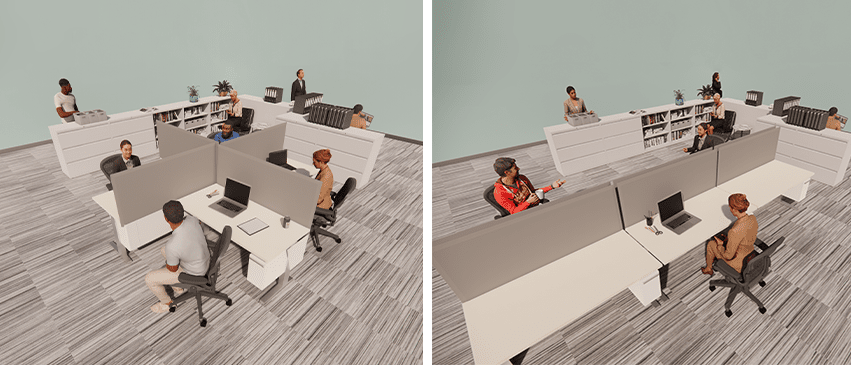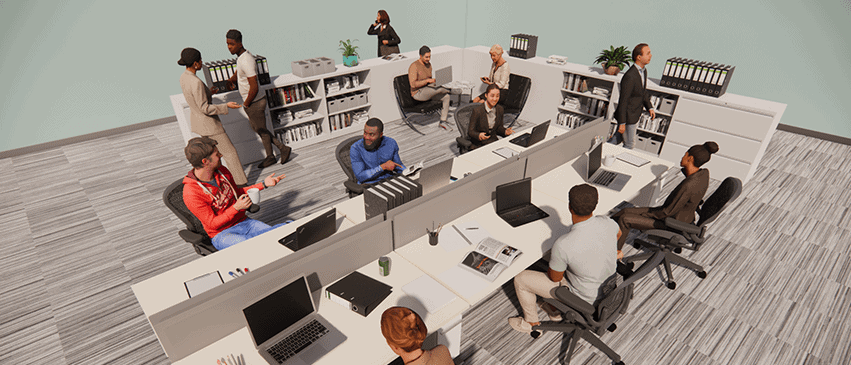As a result of the COVID-19 pandemic, we have all learned one thing: change happens. Whether we are the kind of people who embrace change like a warm, welcoming hug, or the reluctant nonconformists who hold on to our routines and schedules with an iron fist, change is all around us. Characterized by many as a “dumpster fire” or the “year that never ends,” 2020 shoved—and I mean really shoved—the workforce into a very rapid sense of change that took us all by surprise. As we enter 2021 and look to the future, we can still see the harsh impact of 2020 in the rearview mirror. We are not 100% equipped to forge ahead without making more change. While these changes cannot happen overnight, we must be ready to embrace our flexibility and roll with the punches.
So, what do we do now? As the COVID-19 vaccine becomes more readily available, many people will be returning to the workplace. Are we all going to return at the same time? We know employers already had been reviewing their work environments prior to the pandemic. The concept of trying to optimize a workspace for maximum staff productivity and efficiency is not new. However, as we try to rejoin the land of person-to-person connection, how do we keep employees safe, healthy and productive? How can businesses make the best use of their current physical assets without taking on new financial burden as they implement change? This is easier said than done, and each solution is dependent on the specific type of work environment (e.g. offices, retail space, hospitals). Consider these strategies that can impact the physical environment as we re-enter the workplace.
Evaluate, Review, Implement, Adapt
There are four high-level processes to consider when creating a plan for re-entry into the workplace. First, evaluate the current environment to identify any strengths and weaknesses per the business model standards or local guidelines. Prioritize what changes need to be made, and review options for immediate and long-term solutions. Consider how will they impact employee safety, health and performance. Once those changes are implemented, consider the successes and failures of the plan, and adapt as necessary.
What are today’s expectations of business owners and employees? Do employees feel safe in the work environment? Sometimes psychological safety can be more important than physical safety. An individual’s perception of cleanliness or physical distance can influence their acceptance of an environment or situation, no matter what the facts may be. What can be done to the physical space to help promote safety? As with any good idea, these possible solutions are not a cure-all for every workplace. Each plan should be evaluated with specific goals in mind. After implementing any physical or behavioral changes, review the plan for any successes and failures. Not every plan will be a huge success the first time, so be open to changing the plan as required.

Workforce Strategies
Does the employer support a distributed way of working? This type of work is done by team members who are not in the same physical location when working on a project. Before the pandemic, it was generally expected that employees be physically present in their place of business to perform their jobs. However, during this unprecedented shift in history, much of the workforce has successfully proven the ability to work from anywhere—forcing business leaders to evaluate their plans moving forward.
Perhaps a business can establish long-term flexible policies which allow employees to determine their in-person workdays balanced with working from their home office. If an employee is required in the workplace for only two days a week, that same workspace can be used by other employees the rest of the week. This strategy will result in a decreased number of people in the workplace, as well as a possible reduction (or removal) of physical assets. With fewer people in an office environment, furniture can be reconfigured to allow for additional small-group, socially distanced settings; more open circulation; and flexible space for future growth. Including outdoor work areas (when weather permits) can be a definite bonus, both for the employee’s mental and physical health, and for keeping people physically distanced from one another.
Another solution is to implement some simple strategies to decrease physical interaction. Creating a one-way path of travel through the workspace will limit the number of occupants in corridors. Removing every other chair in larger workstation environments and large communal areas can result in a greater distance between people. Reconfiguring a two-sided furniture grouping into a pinwheel shape where everyone is facing a different direction can increase separation. Consider using taller units, such as bookcases or storage cabinets, to create a physical separation between a walkway and an open work area. Many furniture manufacturers have mobile screen options that can be dual-performing: surfaces can be finished as a whiteboard or tackable surface, while the screen itself is a barrier. Mobile and modular furniture components are key to allowing for the greatest flexibility and ease of reconfiguration.
When hosting in-person meetings, how can we support collaboration and togetherness but still maintain our distance? Going back to our knowledge of basic shapes can be a benefit for all. Table and chair groupings configured in non-side-by-side shapes such as hexagons or triangles can provide additional distance between users. The shape of the table will determine the placement of the chair. Utilizing a change in surface heights when engaging in conversation can also be helpful. A person who is standing at one end of a table will be more physically separated from those who are in a seated position at another standard-height table.
The use of virtual connectivity has increased by an unprecedented amount during the COVID-19 pandemic. Virtual communication is likely here to stay, so maximizing your business’ technological capabilities can be a sound investment. When hosting virtual meetings with participants in various locations, does the technology and physical environment support this function in the best way possible? It may be time to evaluate your environment and review items that need to be updated. Enhanced lighting and permanent equipment will look better, sound better, and present a more professional atmosphere than a laptop’s poor view of your makeshift workspace.
The Cycle of Change
After nearly a year into the “new normal” of working from home, staying socially distant from one another, and adapting to new lifestyles, it is clear that change has become part of our everyday routine. In the coming months, more of the workforce will re-enter their place of business. It may be some time before we can experience life as we once knew it, without social distancing, masks and constant temperature checks. Until that day arrives, we must continue to review our environments, consider making changes, study their strengths and weaknesses, and be flexible enough to adapt them with needed improvements. Keeping our workforce safe, healthy and productive will be key for continued success—only to repeat the cycle again as change is… always changing. PM
Janelle Payne, NCIDQ, IIDA, LEED AP, is interior design manager in Farnsworth Group’s Peoria office.




